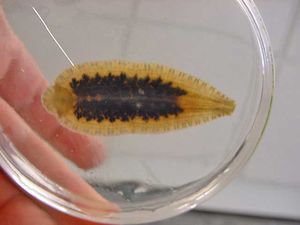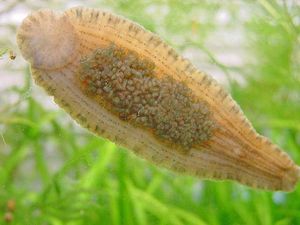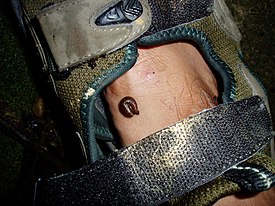Leech
| Leeches | ||||||||
|---|---|---|---|---|---|---|---|---|
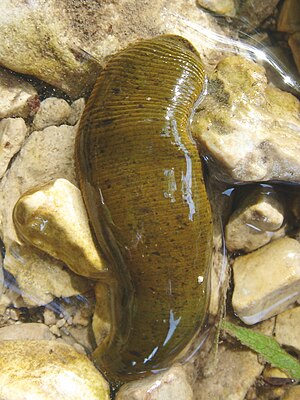 A Leech on stones
| ||||||||
| Scientific classification | ||||||||
| ||||||||
| Orders | ||||||||
|
Arhynchobdellida or Rhynchobdellida |
Leeches are annelids comprising the subclass Euhirudinea. There are freshwater, terrestrial and marine leeches. Like their near relatives, the Oligochaeta, they share the presence of a clitellum. Like earthworms, leeches are hermaphrodites. The medicinal leech, Hirudo medicinalis, which is native to Europe, and its congeners have been used for clinical bloodletting for thousands of years. This article is about the invertebrate animals (some are blood sucking, others are not).
All leech species are carnivorous. Some are predatory, feeding on a variety of invertebrates such as worms, snails, insect larvae, crustaceans, while a very few are temporary sanguivorous ectoparasitic (haemophagic parasitic) or blood-sucking leeches, feeding on the blood of vertebrates such as amphibians, reptiles, waterfowl, fishes, and mammals (including humans). Sanguivorous (Haemophagic) leeches attach to their hosts and remain there until they become full, at which point they fall off to digest their blood meal (this may take weeks or even months). The most important predators on leeches are waterfowl, fish, aquatic insects, crayfish and other leeches specialized for predation on leeches.
The bodies of Leeches are composed of 32 post-oral metameres (true body segments) and two pre-oral non-metameric segments, the prostomium and peristomium. The body is comprised of five generally recognized regions, the head (2 pre-oral and 4 postoral segments), trachelosome (6 segments), urosome (12 segments), anal region (3 segments) and caudal sucker (7 segments). They all have an anterior (oral) sucker and a posterior (anal or caudal) sucker formed from the last seven segments of their body. The oral sucker contains the mouth and is used to connect to a host for feeding. They use a combination of mucus and suction (caused by concentric muscles in the sucker) to stay attached. Leech saliva contains several compounds including a hyaluronidase (increases the permeability of the host skin, a histamine-like compound or vasodilator (dilates the blood vessels), an anticoagulant (prevents blood clots or breaks apart clots) and possibly an anesthetic.
Species in the family Glossiphniidae have extended post-hatching care of their young and will nurture their young, providing food, transport, and protection.
Origin
The leeches are presumed to have evolved from the Oligochaeta, most of which feed on detritus. However, some species in the Lumbriculidae are predaceous and have similar adaptations to the leeches.
Taxonomy
True leeches, of the subclass Euhirudinea, with both anterior and posterior suckers, are divided into two groups:
- Rhynchobdellae: "jawless" leeches, armed with a muscular straw-like proboscis puncturing organ in a retractable sheath. The Rhychobdellae consist of two families: The Glossiphoniidae (flattened leeches with a poorly defined anterior sucker) and the Piscicolidae (have cylindrical bodies and a usually well-marked, bell-shaped, anterior sucker). The Glossiphoniidae live in fresh-water habitats; the Pisciolidae are found in sea-water habitats.
- Arhychobdellids: Leeches which lack a proboscis and which may or may not have jaws armed with teeth. Arhychobdellids are divided into two orders: Gnathobdellae and Pharyngobdellae
- Gnathobdellae: In this order of "jawed" leeches, armed with teeth, is found THE quintessential leech: the European medical (bloodsucking) leech, Hiruda medicinalis. It has a tripartite jaw filled with hundreds of tiny sharp teeth. The incision mark left on the skin by the European medical leech is an inverted Y inside a circle: the insignia of Mercedes Benz. Within this order, the family Hirudidae is characterized by aquatic leeches and the family Haemadipsidae by terrestrial leeches.
- Pharyngobdellae: These so called worm-leeches consist of freshwater or amphibious leeches that have lost the ability to penetrate a host's tissue and suck blood. They are carnivorous and equipped with a relatively large, toothless, mouth to ingest worms or insect larvae, which are swallowed whole.
The Pharyngobdellae have six to eight pairs of eyes, as compared with five pairs in gnathobdelliform leeches, and include three related families. The Erpobdellidae are some species from freshwater habitats.
Use of Hirudo medicinalis in medicine
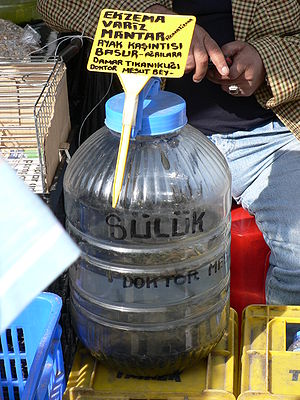
The leech has long been used in medicine, although today its use is mainly limited to limb reattachment procedures instead of the wide-ranging medical use of the past. Leeches were once so commonly used that doctors were popularly called leeches. In Old High German, lāhhi (etymon of leech) means "physician".
Leech saliva contains a number of compounds which assist in its feeding. An anaesthetic limits the sensations felt by the host (and thus reduces the chance of the host trying to detach the leech). A vasodilator causes the blood vessels near the leech to become dilated, and thus provide the leech with a better supply.
Lastly, the leech saliva contains a peptide called hirudin, which is a highly effective anticoagulant. The leech needs this to prevent blood clots (which would block its feeding) from forming in the wound created by its mouthparts. These properties are difficult to achieve using other medical techniques, and it is for this reason that leeches have come back into clinical practice in the last 25 years. The small amounts of hirudin present in leeches makes it unsuitable to be harvested for more general medical use, so hirudin (or related chemicals) have been synthesised using recombinant-DNA technology.
Bdellatomy is the practice of cutting the leech open slightly while it is sucking blood to let the blood in it out, so, thinking that it is not full yet, the leech continues to bite instead of detaching itself. This practice was first recorded in 1868 by Daily News.
The anatomy of medicinal leeches
The anatomy of medicinal leeches may look simple, but more details are found beyond the macro level. Externally, medicinal leeches tend to have a brown and red striped design on an olive colored background. These organisms have two suckers, one at each end, called the anterior and posterior sucker. The posterior is mainly used for leverage while the anterior sucker, consisting of the jaw and teeth, is where the feeding takes place. Medicinal leeches have three jaws that look like little saws, and on them are about 100 sharp teeth used to incise the host.
Reproduction
Leeches are hermaphrodites, meaning they are organisms that have both female, ovary, and male, testes, sexual reproductive organs.
Nutrition of leeches
Starting from the anterior sucker is the jaw, the Pharynx which extends to the crop, which leads to the Intestinum, where it ends at the posterior sucker. The crop is a type of stomach that works like an expandable storage compartment. The crop allows a leech to store blood up to five times its body size; because of this ability to hold blood without the blood decaying, due to bacteria living inside the crop, medicinal leeches only need to feed two times a year.
It was long thought that bacteria in the gut carried on digestion for the leech instead of endogenous enzymes which are very low or absent in the intestine. Relatively recently it has been discovered that, ALL leeches and leech species studied do produce endogenous intestinal exopeptidases which can unlink free terminal-end amino acids, one amino acid monomer at a time, from a gradually unwinding and degrading protein polymer. However, unzipping of the protein can start from either the amino (tail) or carboxyl (head) terminal-end of the protein molecule. It just so happens that the leech exopeptidase (arylamidases), possibly aided by proteases from endosymbiotic bacteria in the intestine, starts from the tail or amino protein, free-end , slowly but progressively removing many hundreds of individual terminal amino acids for resynthesis into proteins that constitute the leech. Since leeches lack endopeptidases, the mechanism of protein digestion can not follow the same sequence as it would in all other animals where exopeptidases act sequentially on peptides produced by the action of endopeptidases. Exopeptidases are especially prominent in our common North American worm-leech Erpobdella punctata. This evolutionary choice of exopeptic digestion in Hirudinea distinguishes these carnivorous clitellates from Oligochaeta.
Deficiency of digestive enzymes (except exopeptidases) but more importantly deficiency of vitamins, B complex for example, in leeches is compensated for by enzymes and vitamins produced by endosymbiotic microflora. In Hrudo medicinalis these supplementary factors are produced by an obligatory symbiotic relationship with a single bacterium species, Aeromonas hydrophila, which maintains itself in pure culture by secreting an antibiotic known to medicine since the 19th century, well before Fleming's 1929 discovery of penicillin. Non-bloodsucking leeches such as E.punctata are host to three bacterial symbionts, Pseudomonas sp, Aeromonas sp, and Klebsiella sp (a slime producer). The bacteria are passed from parent to offspring in the cocoon as it is formed.
The effects of leech bites
There is not much that can be done to prevent leech bites in the outdoors. There is little evidence in favor of any leech-repellant (unlike the strong evidence in favour of DEET against biting insects). The most effective step is not to expose bare skin, preferably by wearing leech socks.
Leech socks are calico oversocks worn outside the trousers which provide a degree of protection, since they prevent leech entry at ankle level. They are usually made of pale material to make it easy to spot leeches as they climb looking for an area of bare skin.
It is common practice for people leaving leech-infested waters or wet vegetation to conduct a visual inspection of themselves to ensure that no leeches are attached.
If a leech bites, it should be removed and the wound cleaned. There is an urban legend that if the biting parts of the leech are left in the wound, healing is inhibited. There is no evidence in favor of such an assertion. Never salt or burn a leech to remove it. The leech will convulse and regurgitate blood back into the wound, creating risk of bacterial infection. Instead, simply removing the head from the feeding site with a fingernail will safely detach the leech. Another alternative is to let the leech feed until it is full, after which it will drop off on its own.
Calcium hydroxide diluted in water can be sprayed either as a deterrent or onto the animal when it is attached. The solution causes the leech to disintegrate. However this also may damage the surface of the skin.
Other substances that cause the leech to disintegrate are heat rubs, which are safe to apply on one's skin. The leeches have an adverse reaction to the menthol contained in heat rubs and will detach themselves immediately upon contact with the substance.
There is little evidence of transmission of disease through leech bites. Leeches do carry parasites in their digestive tract, but these cannot survive in humans at this stage in their life cycle and so pose no threat. If the wound is cleaned, there is little risk of infection (as with any other small wound). The wound should not be scratched as this may introduce other infections.
Prevention
There are several ways in which people inhabiting leech-infested areas avoid leech bites. The most common is to rub salt on to the exposed skin areas, such as hands and feet. Another involves the use of baking soda. In addition to these home remedies, several insect sprays also prevent leech bites. But these remedies can cause harmful allergic reactions in some people.
Attribution
- Some content on this page may previously have appeared on Wikipedia.
References
